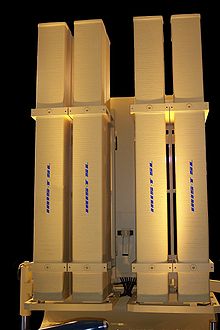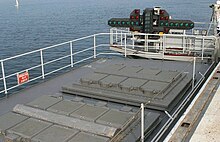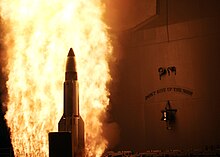Vertical launching system: Difference between revisions
L&T system not a true VLS system and is NOT operational. REMOVED. Again, India cannot take credit for the Russian 3S14E VLS. |
|||
| Line 73: | Line 73: | ||
The [[Type 051C destroyer]], [[Type 052C destroyer]], [[Type 052B destroyer]] and [[Type 054 frigate|Type 054A frigate]] also have a VLS system, the latter similar in outward appearance with the American Mk 41. |
The [[Type 051C destroyer]], [[Type 052C destroyer]], [[Type 052B destroyer]] and [[Type 054 frigate|Type 054A frigate]] also have a VLS system, the latter similar in outward appearance with the American Mk 41. |
||
===India=== |
|||
[[Larsen and Tubro]] developed the Universal vertical launching system for [[Brahmos]] cruise missile to equip Indian Navy warships and for the Indian Army.<ref>[http://www.larsentoubro.com/lntcorporate/LnT_Offerings/Product_Template1.aspx?res=P_HED_COFF_SBU_PROD&pid=1857&sbu=75 Universal Vertical Missile Launcher(BrahMos)]</ref> |
|||
The Russian, 3S14E vertical missile launcher is fitted on [[Indian Navy]]'s [[Talwar class frigate|''Talwar'' class frigates]], which are derived from Russian [[Krivak class frigate|''Krivak'' class frigates]]. |
|||
== External links == |
== External links == |
||
Revision as of 11:59, 6 July 2009
This article needs additional citations for verification. (March 2008) |

A vertical launching system (VLS) is a type of missile-firing system used aboard the submarines and surface vessels of several navies around the world.
Derived from the launch systems developed for ballistic missiles aboard SSBNs, a VLS forms a scaled-down equivalent for launching cruise missiles such as the Tomahawk and surface-to-air missiles (SAMs) such as the Standard missile. The system enables SSNs (nuclear-powered attack submarines) to carry more weapons in addition to their torpedo tubes. More significantly, VLSs allow both submarines and surface combatants to have more weapons ready for firing at a given time than with other launching systems such as the Mk-13 single-arm and Mk-26 twin-arm launchers, which were fed from behind by a magazine below the main deck on older guided-missile cruisers, destroyers, and frigates, all of which have been removed from service by the USN, or else had their surface-to-air missiles removed (Oliver Hazard Perry-class guided-missile frigates.) The Mk-13 and the Mk-26 remain in service on ships that were sold to other countries such as, Taiwan, Greece, and Poland.
Hot launch and cold launch
Western VLSs have the missile cells arranged in a grid with one lid per cell and are "hot launch" systems, i.e. the engine ignites within the cell during the launch, and thus it requires exhaust piping for the missile flames and gasses, while Russia produces both grid systems and a revolver design with more than one missile per lid, and the People's Republic of China uses a circular "cold launch" system that ejects the missile from the launch tube before igniting the engine. Russia also uses a cold launch system for some of its VLS missile systems (eg. Tor).
The advantage the hot-launch system has over the cold-launch system is that the missile propels itself out of the launching cell using its own engine. This reduces the additional weight, size, maintenance requirement, and initial production cost for the additional power sources the cold-launch system uses to propel the missile out. The missiles of the hot-launch system also come out of their tubes immediately ready to start seeking their targets.
The advantage of the cold-launch system is in its safety: should the missile engine malfunction while the warhead is armed to detonate during firing, the hot-launch system could be destroyed, but the cold-launch system can still eject the missile out of the cell and eliminate or reduce the threat. For this reason, Russian VLS is often designed with a slanted angle instead of being perpendicular so that when the malfunctioned missile is ejected, it would fall into the water instead of landing on the deck. Another advantage of the cold-launch system is in its low life-cycle cost of the launching tubes: since the engine starts within the tube in a hot-launch system during launches, the tubes of the hot-launch system can only sustain a limited number of launches - after which the tube must be replaced (just like in the large naval guns of obsolete & retired ships). A cold-launch system, in contrast, can last much longer because the tubes are not subject to the extreme heat blasts compared to the hot-launch system's.
VLS types
Africa
Umkhonto (South-Africa)
The Umkhonto missile is a new (2005–) hot-launched from eight cell containers. Their radar fire control system can engage eight targets simultaneously guiding the missile to a specific point using initial target information and inertial navigation before switching to infrared homing. It will used by:
 Finnish Navy — Hamina class missile boats and Hämeenmaa class minelayers
Finnish Navy — Hamina class missile boats and Hämeenmaa class minelayers Swedish Navy — the stealth Visby class corvettes
Swedish Navy — the stealth Visby class corvettes South African Navy — Valour class frigates (MEKO A-200)
South African Navy — Valour class frigates (MEKO A-200)
Europe

SYLVER (France)
The SYLVER vertical launching system manufactured by DCN is being deployed on a wide range of European naval vessels, and like most western designs, it is a hot-launch system. Like the USA Mk 41 VLS, the Sylver VLS shares a single flame and gas exhaust system across several launching cells.
The primary application of the launcher has been the MBDA Aster missile. The SYLVER, together with the Aster, is the primary component of the PAAMS naval anti-air warfare system to be fitted to British Type 45 destroyers and French and Italian Horizon class frigates. France's Charles de Gaulle nuclear aircraft carrier is fitted with four 8-cell SYLVER launchers carrying the MBDA Aster 15. The SYLVER has a higher maximum rate of fire than any other vertical launch system currently in service: it only takes 150 milliseconds to fire a missile.
The French Navy has initiated studies to convert the SCALP EG missile to be capable of launch from the SYLVER. This missile, the SCALP Naval, would give France a land attack capability in the mould of the U.S. Tomahawk missile. It would also be attractive to the Royal Navy.
Exported La Fayette class frigates use SYLVER launchers, except for those that were sold to Taiwan.
VL Sea Wolf (UK)
The Royal Navy uses the GWS 26 VLS (Vertical Launch Sea Wolf) version of the Sea Wolf SAM aboard its Type 23 frigates. This is a 32 cell VLS mounted on the foredeck just behind the 114 mm (4.5 in) gun. This system, like all other western designs, is a hot-launch system. Unlike the Mk-41 VLS of USA, Sea Wolf VLS has a different flame and gas exhaust system in that each individual cell has its own flame and gas exhaust system: each cell contains four flame and gas exhaust pipes which are arranged between the control surfaces of the Sea Wolf SAM, and as a result, the Sea Wolf VLS is limited to launching Sea Wolf only, and thus less versatile than the Mk 41-VLS of USA or the French Sylver VLS.
United States of America

Submarine VLS
In addition to surface ships, all Virginia-class submarines and USS Providence (SSN-719) and later 688i Los Angeles-class submarines have had VLS systems installed - for surface-attack missiles like the Tomahawk, and not for surface-to-air missiles. The maximum rate of fire for these launchers is said to be about one missile per second. The U.S. Navy has modified the four oldest USS Ohio-class submarines to an SSGN configuration, allowing them to carry up to 154 Tomahawk cruise missiles launched from VLS installed in tubes that previously held Trident strategic ballistic missiles.
Mark 41 or Mk-41
The current generation of American-produced vertical launch system is known as the Mark-41 Guided Missile Launch System or Mk-41 VLS. It is capable of carrying a wide variety of missiles in 8 cells per module, including the Evolved Sea Sparrow Missile (RIM-162 ESSM) naval self-defense short-range SAM, the RIM-66 Standard missile medium range SM-2 air-defense missile, the RIM-161 Standard missile 3, SM-3 anti-ballistic missile, the VLA (vertical-launch ASROC missile) anti-submarine missile, and the Tomahawk cruise missile. There are also proposals to increase the number of missiles the Mk-41 is capable of carrying in each firing tube. Mk 41 VLS adopts modular design concept, which result in different versions that vary in size and weight. The length comes in three sizes: 209 inches for the self-defense version, 266 inches for the tactical version, and 303 inches for the strike version. The empty weight for a 8-cell module is 26,800 pounds for the self-defense version, 29,800 pounds for the tactical version, and 32,000 pounds for the strike version.

For the American surface ships, the Mk-41 VLS replaced the Armored Box Launcher system and the Mk 13 single-arm & Mk 10, Mk 11 and Mk 26 twin-arm missile launcher systems that were previously used by United States Navy ships to fire surface-to-air missiles. All the US Arleigh Burke class destroyers and the 22 active-service Ticonderoga class cruisers use the Mk-41 VLS for all guided missiles except for their Harpoon missiles, which have a separate launcher. Because of the versatility of the Mk-41 VLS, other US surface ships that had Armored Box Launchers or other slanted firing systems have been retrofitted with VLS (the first five Ticonderoga class ships were not so refit). Some of the 31 USN Spruance-class destroyers were upgraded with the Mk-41 VLS, but all of these warships have now been retired from active service. The Mk-41s on those ships were used to carry Tomahawk and ASROC missiles, as they had no AEGIS radar, and could not fire Standard Missiles.
Other applications for the Mk-41 are the Japanese Kongō class destroyers, the South Korean KDX-III class destroyers, the Spanish Álvaro de Bazán class frigates, the under-construction Norwegian Fridtjof Nansen class frigates, the German Navy's Sachsen, Brandenburg, and F125 class frigates, the Canadian Iroquois class destroyers, the Anzac class frigates of the Royal Australian Navy and the Royal New Zealand Navy, the four upgraded Royal Australian Navy Adelaide class frigates, the three planned Australian Hobart class destroyers, the De Zeven Provinciën class frigates of the Royal Netherlands Navy, the South Korean KDX II class destroyers, the Israeli Navy's Sa'ar 5 class corvettes, Turkish Navy's Milgem class corvettes, MEKO-200 frigates, G class frigates, and proposed TF-2000 class AAW frigates, and selected for the Danish Navy's Ivar Huitfeldt-class of frigates.
Mk-48
Mk-48 VLS is another vertical launching system used by the United States Navy and its allies. Mk-48 VLS is designed to launch RIM-162 ESSM Sea Sparrow SAM. Like its larger cousin Mk-41, Mk-48 also adopts modular design concept, and the smallest one is consisted of two cells. The 2-cell module of Mk-48 makes the system very versatle, enables it to be installed onboard in spaces that is otherwise cannot be utilized. The weight of a 2-cell module of Mk-48 is 1,450 pounds (with empty canisters), 725 pounds for exhaust system, and 800 pounds for ship installation interfaces. Each canister of the Mk-48 VLS houses a single RIM-162 ESSM, though with modification, other missiles can also be launched.
Mk-57
Raytheon and BAE are currently developing the next generation of the vertical launch system, designated the Mk-57, for use in the Zumwalt class destroyers and for future ships. The most notable difference between the MK-57 and the Mk-41 will be the MK-57's ability to carry missiles in peripherally-placed VLS cells, theoretically reducing the number of missiles lost in the event of combat damage, and also reducing the chance of the loss of a warship from an explosion. There is also the possibility that the peripherally-placed missiles might eventually be useful as a form of explosive reactive armor. Standard Missiles can be quad-packed in a single Mk-57 VLS cell,[1] so the 80 cells in the Zumwalt-class design could theoretically carry a total of 320 Standard missiles. However, the Zumwalts are intended for land attack and would primarily carry Tomahawks (or equivalents), plus some ASROC missiles for defense against submarines.
Russia

The Soviet/Russian SA-N-6 Grumble fitted to the Kirov-class and the Slava-class uses a revolver-style VLS. The SA-N-6 Grumble VLS utilises cold launch method by adopting a coal-gas ignition system: the coal-gas within the ignition chamber directly below the cell ignites and thus sets the piston into motion, resulting in the SAM being ejected out of the cell. The system adopts a revolver design in which a cell contains 8 launching tubes, each containing a single missile, so that during the launch, the cell has to be rotated into the position in order to launch the SAM that is to be fired. In case of the failure of the ignition of the rocket motor after the missile has been ejected, the launching tubes are tilted 5 degrees instead of being absolutely perpendicular, so that the missile with the failed motor would not fall back onboard.
The shorter-ranged SA-N-9 Gauntlet is another VLS missile, used on the Kirov-class, Udaloy-class and the aircraft carrier Admiral Kuznetsov.
The SS-N-19 Shipwreck/P-700 Granit is also a VLS missile, fired from below-deck tubes on the Kirov-class and the Oscar class submarine. These tubes are angled due to the length of the missile, and thus not strictly vertical launch, but the system otherwise meets the definition.
People's Republic of China

PLAN Type 052B Guangzhou class destroyers (DDG) were the first Chinese ships to have a VLS. The system is an improvement of the Russian SA-N-6 SAM VLS and uses the same cold gas ignition method. The Chinese VLS eliminates the revolver design by providing separate lids for the launch tubes, which are each capable of independently firing the missile inside because each has a cold-gas ignition chamber directly below. The Chinese Navy claims this results in simplified maintenance, decreased size, weight, and cost. Furthermore, due to the elimination of the revolver mechanism, the power consumption is reportedly reduced as well.
The Type 051C destroyer, Type 052C destroyer, Type 052B destroyer and Type 054A frigate also have a VLS system, the latter similar in outward appearance with the American Mk 41.
India
Larsen and Tubro developed the Universal vertical launching system for Brahmos cruise missile to equip Indian Navy warships and for the Indian Army.[2]
The Russian, 3S14E vertical missile launcher is fitted on Indian Navy's Talwar class frigates, which are derived from Russian Krivak class frigates.
External links
References
- ^ Friedman, Norman (2006), The Naval Institute Guide to World Naval Weapon Systems, Naval Institute Press, p. 601, ISBN 9781557502629
- ^ Universal Vertical Missile Launcher(BrahMos)
